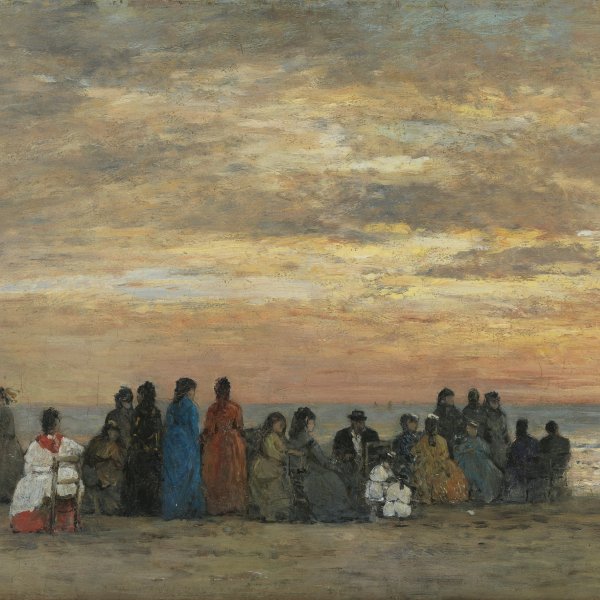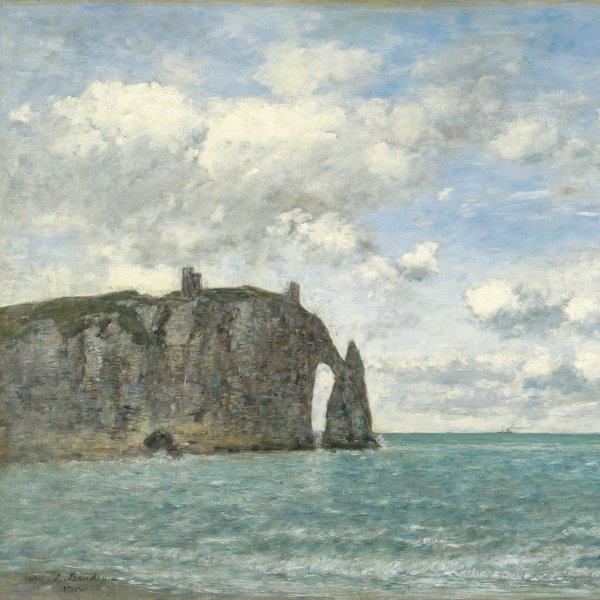Eugène Boudin
Honfleur, 1824-Deauville, 1898
The French painter Eugène Boudin is regarded as one of the forerunners of the Impressionist movement. His fondness for painting from life and his fascination with studying the effects of light provided an example to follow for the young painter Claude Monet, to whom he was linked by a close friendship.
At the age of ten, Boudin, a seaman’s son, was cabin boy on his father’s boat. Although he soon abandoned the trade, the painter retained a close bond with the sea, which became the subject of many of his works. He worked in The Hague with a local printer and later at a stationer’s shop. During this period he came into contact with the artists Théodule Ribot, Thomas Couture, Jean-François Millet, Constant Troyon and Eugène Isabey, who influenced his decision to devote himself fully to painting and to move to Paris in 1847. His initial period was chiefly influenced by seventeenth-century Dutch painting and the work of his contemporaries of the Barbizon School.
Boudin went several times to Brittany after 1855. The region’s landscape and its customs, streets, churches and markets became a theme of his painting. Thenceforward his trips to the coast of Normandy and Brittany were regularly interspersed with stays in Paris or Deauville, where he took up residence in 1884. In 1859 he met Gustave Courbet, showed his work for the first time at the Paris Salon, and was praised by Charles Baudelaire. During the 1860s Boudin produced many works featuring groups of summer holiday makers on the beaches of Trouville, which were very well received on the French art scene.
In 1874 he took part in the first Impressionist exhibition on the boulevard des Capucines. Towards the end of his life, between 1892 and 1895, he made three trips to Venice in search of fresh inspiration. He was awarded the gold medal of the Exposition Universelle in 1895, three years before his death.
At the age of ten, Boudin, a seaman’s son, was cabin boy on his father’s boat. Although he soon abandoned the trade, the painter retained a close bond with the sea, which became the subject of many of his works. He worked in The Hague with a local printer and later at a stationer’s shop. During this period he came into contact with the artists Théodule Ribot, Thomas Couture, Jean-François Millet, Constant Troyon and Eugène Isabey, who influenced his decision to devote himself fully to painting and to move to Paris in 1847. His initial period was chiefly influenced by seventeenth-century Dutch painting and the work of his contemporaries of the Barbizon School.
Boudin went several times to Brittany after 1855. The region’s landscape and its customs, streets, churches and markets became a theme of his painting. Thenceforward his trips to the coast of Normandy and Brittany were regularly interspersed with stays in Paris or Deauville, where he took up residence in 1884. In 1859 he met Gustave Courbet, showed his work for the first time at the Paris Salon, and was praised by Charles Baudelaire. During the 1860s Boudin produced many works featuring groups of summer holiday makers on the beaches of Trouville, which were very well received on the French art scene.
In 1874 he took part in the first Impressionist exhibition on the boulevard des Capucines. Towards the end of his life, between 1892 and 1895, he made three trips to Venice in search of fresh inspiration. He was awarded the gold medal of the Exposition Universelle in 1895, three years before his death.








